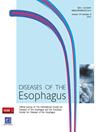759. P02.04 PARAVERTEBRAL VERSUS EPIDURAL ANALGESIA IN MINIMALLY INVASIVE ESOPHAGEAL RESECTION (PEPMEN): A RANDOMIZED CONTROLLED MULTICENTER TRIAL
IF 2.3
3区 医学
Q3 GASTROENTEROLOGY & HEPATOLOGY
引用次数: 0
Abstract
Background Thoracic epidural analgesia has been the mainstay for pain control in esophageal cancer patients undergoing minimally invasive esophagectomy (MIE). Although effective epidural analgesia potentially contributes to achieving enhanced recovery after surgery (ERAS) goals in patients undergoing MIE, it can have counterproductive side effects such as hypotension, urinary retention and reduced mobility. Paravertebral analgesia may be a promising alternative to epidural analgesia, avoiding potential side effects and improving postoperative recovery. Methods This open randomized controlled superiority trial was conducted across four Dutch centers. A total of 192 patients with esophageal cancer, scheduled for elective transthoracic MIE with intrathoracic anastomosis, were included and randomized to receive either epidural analgesia or paravertebral analgesia. The primary outcome was Quality of Recovery (QoR-40) on the third postoperative day (POD). Secondary outcomes included the quality of life, postoperative pain, opioid consumption, need for inotropic/vasopressor medication, duration of admission, mobilization, complications, readmission, and mortality. Results From December 2019 to February 2023, 94 patients were assigned to epidural and 98 to paravertebral analgesia. QoR-40 score on POD3 did not differ between groups (mean difference 3.7; P=.268). The epidural group had higher QoR-40 scores on POD1 and 2 (mean difference 7.7; P=.018, mean difference 7.3; P=.020) and lower pain scores (1 versus 2; P=<.001, 1 versus 2; P=.033). More patients in the epidural group required vasopressor-medication on POD1 (38.3% versus 13.3%; P<.001). In the paravertebral group, the urinary catheter was removed one day earlier (P=<.001). No significant differences in complications or length of stay were observed. Conclusion This multicenter randomized controlled clinical trial did not show superiority of paravertebral analgesia over epidural analgesia in quality of recovery on the third day after minimally invasive esophagectomy. These results, however, support the safety of paravertebral analgesia as a viable alternative to epidural analgesia, enabling the provision of both techniques to patients in clinical practice.759.P02.04 微创食管切除术(Pepmen)中的椎旁镇痛与硬膜外镇痛:随机对照多中心试验
背景 胸腔硬膜外镇痛一直是接受微创食管切除术(MIE)的食管癌患者控制疼痛的主要方法。虽然有效的硬膜外镇痛可帮助接受微创食管切除术(MIE)的患者实现术后康复(ERAS)目标,但它可能会产生低血压、尿潴留和行动不便等副作用。椎旁镇痛可能是硬膜外镇痛的一种有前途的替代方法,可避免潜在的副作用并改善术后恢复。方法 这项开放式随机对照优越性试验在荷兰的四个中心进行。共有 192 名食道癌患者被纳入其中,计划接受择期经胸 MIE 和胸腔内吻合术,并随机接受硬膜外镇痛或椎旁镇痛。主要结果是术后第三天(POD)的恢复质量(QoR-40)。次要结果包括生活质量、术后疼痛、阿片类药物消耗、肌力/血管加压药物需求、入院时间、活动能力、并发症、再入院和死亡率。结果 从2019年12月到2023年2月,94名患者被分配到硬膜外镇痛,98名患者被分配到椎旁镇痛。POD3的QoR-40评分在组间无差异(平均差异为3.7;P=.268)。硬膜外组在 POD1 和 2 的 QoR-40 评分更高(平均差 7.7;P=.018,平均差 7.3;P=.020),疼痛评分更低(1 对 2;P=<.001,1 对 2;P=.033)。硬膜外组中有更多患者在POD1时需要使用血管加压药物(38.3%对13.3%;P<.001)。在椎旁组,导尿管提前一天拔除(P=<.001)。在并发症或住院时间方面没有观察到明显差异。结论 这项多中心随机对照临床试验并未显示椎旁镇痛在微创食管切除术后第三天的恢复质量方面优于硬膜外镇痛。不过,这些结果支持椎旁镇痛作为硬膜外镇痛的可行替代方法的安全性,使临床实践中能够为患者提供这两种技术。
本文章由计算机程序翻译,如有差异,请以英文原文为准。
求助全文
约1分钟内获得全文
求助全文
来源期刊

Diseases of the Esophagus
医学-胃肠肝病学
CiteScore
5.30
自引率
7.70%
发文量
568
审稿时长
6 months
期刊介绍:
Diseases of the Esophagus covers all aspects of the esophagus - etiology, investigation and diagnosis, and both medical and surgical treatment.
 求助内容:
求助内容: 应助结果提醒方式:
应助结果提醒方式:


